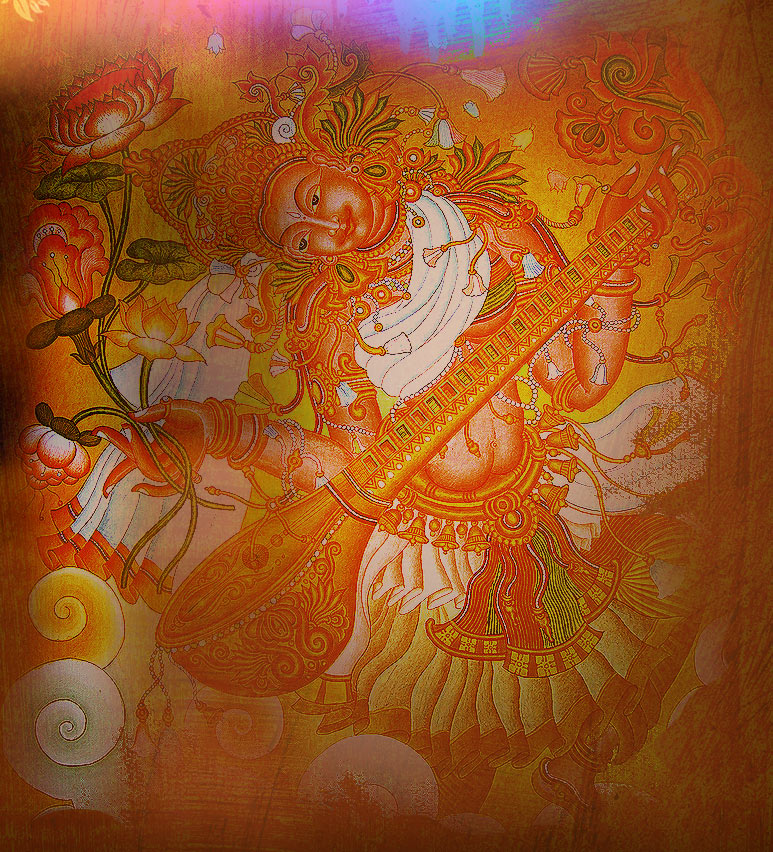
Welcome
Commemoration - through lines with life
Art is in the blood of man from the beginning stages of civilization. It began as a medium to communicate and preserve the events. It has no language but expressions. Every piece of art in Kerala tells us a story. The history Murals in Kerala can be traced to the seventh or eighth century AD. Though the art form developed as a temple art, it soon spread its wings and became universal. The Murals of Kerala bear the stamp of uniqueness in aesthetic composition and technique. Kerala has the second largest collection of archaeologically important mural sites. Ancient places like Padmanabhapuram, Krishnapuram and Mattancherry are enriched with murals. Temples like Padmanabha Swami temple, Panayannarkavu, Pundareekapuram, Ettumanoor, Thruprayar, Kottakkal, Thotteekkalam and Lokanarkavu also have walls decorated with murals. The churches like Kottayam Cheriya Palli, Cheppad Church, Ankamalli Church, Kanjoor Church and Akkapparambu Church also have murals, to decorate their walls. All these are done in Kerala style.
Where to find?
Ancient places like Padmanabhapuram, Krishnapuram and Mattancherry are enriched with murals. Temples like Padmanabha Swami temple, Panayannarkavu, Pundareekapuram, Ettumanoor, Thruprayar, Kottakkal, Thotteekkalam and Lokanarkavu also have walls decorated with murals. The churches like Kottayam Cheriya Palli, Cheppad Church, Ankamalli Church, Kanjoor Church and Akkapparambu Church also have murals, to decorate their walls. All these are done in Kerala style.
Colors and Expressions:
Black, green, red white and yellow and their combinations are used in the murals. Some of them are prepared by grinding soft stones into powder and some, from the saps of leaves. The colour schemes in the murals represent certain symbolic characteristics. Deities depicted in the murals are given colours on the basis of their triple attributes - Sathwikam, Rajasam and Thamasam i.e. Virtuous (the quality of SATHWA) Prosperous (the quality of RAJAS) and ignorant (the quality of THAMAS) respectively. The green represents VIRTUE, and the red and yellowish red, prosperity, while white and black IGNORANCE (white for VAISHNAVITES and black, SAIVITES). The ability of Keralities to restrain emotions is latent in their culture. This outstanding feature is very clearly expressed on the faces of characters depicted in the murals.
Themes:
The themes of murals are mostly taken from the epics and the subjects related to religions. The murals on the outer side of the walls of sanctums and towers represent Gods and Godesses. They embody the qualities characteristics of epic poetry or legends. The Biblical themes like "The Birth of Jesus" "The Cricifixion", The Resurrection", "The Last Supper", "The last Judgment" etc are illustrated on the walls of churches.
The hazing:
I am afraid that these vast treasures of art that have great aesthetic value face decay. Most of them are about to extinct or almost vanishing due to many reasons. Hostile weather, the destructive tendency that caused out of indiscriminate prejudice against art, contemptuous disregard due to indifference and ignorance- all these paved the way for endangering of murals.
Moral obligation:
It is our duty to have an honest effort to protect them from being endangered. We have to preserve them for the posterity. We have to preserve them for the sake of at least the pinch of aesthetic sense that we cuddle.
In Focus
The life and death of Jesus plays an important role in the lives of many, irrespective their religious leanings and hence the focus of this exhibition. Sri Ramakrishna Paramahamsa believed that Jesus was an Incarnation of God. Swami Vivekananda has praised Jesus and cited him as a source of strength and the epitome of perfection. The last stages of Jesus depict rebellion, celebration, camaraderie, betrayal, forbearance, vengeance etc. The Artist immerses himself in those stages and comes up with images that are unique in nature. Paintings are in single colour and depends more on strokes because it is intended for reminding the viewer about the events but do not want the viewer to involve in the events.






